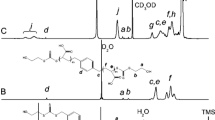Abstract
The objective of the present work was to synthesize interpenetrating networks (IPNs) of acrylic acid/polyvinyl alcohol (AA/PVA) by free radical polymerization using N,N-methylenebisacrylamide (MBAAm) and glutaraldehyde as cross-linkers. The IPNs were evaluated for swelling, diffusion coefficient and network parameters by using Flory–Huggins theory, i.e., the average molecular weight between cross-links (M c), polymer volume fraction in swollen state (V 2,s), number of repeating units between cross-links (M r) and cross-linking density (N). It was found that the degree of swelling of AA/PVA interpenetrating network increases greatly within the pH range 5–7 depending on composition. The gel fraction and porosity increased by increasing the concentration of AA or PVA, while by increasing the degree of cross-linking, porosity decreased and gel fraction increased. Selected samples were loaded with chlorpheniramine maleate as a model drug. Drug release was studied in USP, hydrochloric acid buffer solution of pH 1.2 and phosphate buffer solutions of pH 5.5 and 7.5. Drug release data were fitted into various kinetics models, e.g., zero-order, first-order, Higuchi and Peppas models. The results of the kinetics investigation showed that the drug release from IPNs followed non-Fickian diffusion. Fourier transform infrared spectra confirmed the formation of cross-linked IPNs as there was a shifting to lower frequency of 1,713–1,718 cm−1 with reduced intensity, while scanning electron microscopy revealed uniform distribution of drug in IPNs.





Similar content being viewed by others
References
Sullad AG, Manjeshwar LS, Aminabhavi TM (2010) Novel pH-sensitive hydrogels prepared from the blends of poly(vinyl alcohol) with acrylic acid–graft–guar gum matrixes for Isoniazid delivery. Ind Eng Chem Res 49:7323–7329
Kulkarni AR, Soppimath KS, Aminabhavi TM, Rudzinski WE (2001) In-vitro release kinetics of cefadroxil-loaded sodium alginate interpenetrating network beads. Eur J Pharm Biopharm 51:127–133
Ganji F, Vashenghani-Farahani E (2009) Hydrogels in controlled drug delivery systems. Iran Polym J 18(1):63–88
Hosseinzadeh H (2012) Novel interpenetrating polymer network based on chitosan for the controlled release of cisplatin. J Basic Appl Sci Res 2(3):2200–2203
Devi N, Narzary A (2012) Release dynamics of Brufen from a drug-loaded polymer hydrogel containing polyvinyl alcohol, 2-acrylamide-2- methylpropane sulfonic acid and acrylamide. Int J Polym Mater 61:821–833
Hoffman AS (2002) Hydrogels for biomaterial applications. Adv Drug Deliv Rev 54:3–12
Morita R, Honda R, Takahashi Y (2000) Development of oral controlled release preparations, a PVA swelling controlled release system (SCRS) I. Design of SCRS and its release controlling factor. J Control Rel 63:297–304
Saruchi Kaith BS, Jindal R, Kapur GS (2013) Enzyme-based green approach for the synthesis of gum tragacanth and acrylic acid cross-linked hydrogel: its utilization in controlled fertilizer release and enhancement of water-holding capacity of soil. Iran Polym J 22(8):561–570
Adnadjevic B, Jovanovic J, Drakulic B (2007) Isothermal kinetics of (E)-4(4-metoxyphenyl)-4-oxo-2-butenoic acid release from poly(acrylic acid) hydrogel. Thermochim Acta 466:38–48
Lee JW, Kim SY, Kim SS, Lee YM, Lee KH, Kim SJ (1999) Synthesis and characteristics of interpenetrating polymer network hydrogel composed of chitosan and poly(acrylic acid). J Appl Polym Sci 73:113–120
Ekici S, Saraydin D (2007) Interpenetrating polymeric network hydrogels for potential gastrointestinal drug release. Polym Int 56:1371–1377
Ganguly K, Aminabhavi TM, Kulkarni AR (2011) Colon targeting of 5-fluorouracil using polyethylene glycol cross-linked chitosan microspheres enteric coated with cellulose acetate phthalate. Ind Eng Chem Res 50(21):11797–11807
Mackie JS, Meares P (1955) The diffusion of electrolytes in a cation-exchange resin membrane. Proc Roy Soc Lond A Mat 232:498–509
Flisi U, Crespi G (1968) Polymer–solvent interaction parameters and efficiency of crosslinking of ethylene–propylene copolymers. J Appl Polym Sci 12(8):1947–1957
Britton LN, Ashman RB, Aminabhavi TM, Cassidy PE (1988) Prediction of transport properties of permeants through polymer films: a simple gravimetric experiment. J Chem Educ 65(4):368
Lin C-C, Metters AT (2006) Hydrogels in controlled release formulations: network design and mathematical modeling. Adv Drug Deliver Rev 58:1379–1408
Peppas NA, Zach Hilt J, Khademhosseini A, Langer R (2006) Hydrogels in biology and medicine: from molecular principles to bionanotechnology. Adv Mater 18:1345–1360
Yin L, Fei L, Cui F, Tang C, Yin C (2007) Superporous hydrogels containing poly (acrylic acid-co-acrylamide)/O-carboxymethyl chitosan interpenetrating polymer networks. Biomaterials 28:1258–1266
Line W-J, Lu C-H (2002) Characterization and permeation of microporouspoly(ε-caprolactone) films. J Membrane Sci 198:109–118
Chaturvedi K, Kulkarni AR, Aminabhavi TM (2011) Blend microspheres of poly (3-hydroxybutyrate) and cellulose acetate phthalate for colon delivery of 5-Fluorouracil. Ind Eng Chem Res 50(18):10414–10423
Najib N, Suleiman M (1985) The kinetics of drug release from ethyl cellulose solid dispersions. Drug Dev Ind Pharm 11:2169–2181
Desai SJ, Singh P, Simonelli AP, Higuchi WI (1966) Investigation of factors influencing release of solid drug dispersed in wax matrices III. Quantitative studies involving polyethylene plastic matrix. J Pharm Sci 55:1230–1234
Higuchi T (1963) Mechanism of sustained-action medication. Theoretical analysis of rate of release of solid drugs dispersed in sold matrices. J Pharm Sci 52:1145–1149
Peppas NA (1985) Analysis of Fickian and non-Fickian drug release from polymers. Pharm Acta Helv 60:110–111
Babu RV, Krishna Rao KSV, Sairam M, Naidu BVK, Hosamani KM, Aminabhavi TM (2006) pH Sensitive interpenetrating network microgels of sodium alginate–acrylic acid for the controlled release of ibuprofen. J Appl Polym Sci 99(5):2671–2678
Kurkuri MD, Aminabhavi TM (2004) Poly(vinyl alcohol) and poly(acrylic acid) sequential interpenetrating network pH-sensitive microspheres for the delivery of diclofenac sodium to the intestine. J Control Rel 96(1):9–20
Ranjha NM, Mudassir J, Sheikh ZZ (2011) Synthesis and characterization of pH-sensitive pectin/acrylic acid hydrogels for verapamil release study. Iran Polym J 20:147–159
Said HM, Abd Alla SG, El-Naggar AWM (2004) Synthesis and characterization of novel gel based on carboxymethyl cellulose/acrylic acid prepared by electron beam irradiation. React Funct Polym 61:397–404
Conflict of interest
The authors declare that they have no conflict of interest.
Author information
Authors and Affiliations
Corresponding author
Rights and permissions
About this article
Cite this article
Shah, S., Ranjha, N.M. & Javaid, Z. Development and evaluation of pH-dependent interpenetrating network of acrylic acid/polyvinyl alcohol. Iran Polym J 22, 811–820 (2013). https://doi.org/10.1007/s13726-013-0180-0
Received:
Accepted:
Published:
Issue Date:
DOI: https://doi.org/10.1007/s13726-013-0180-0




